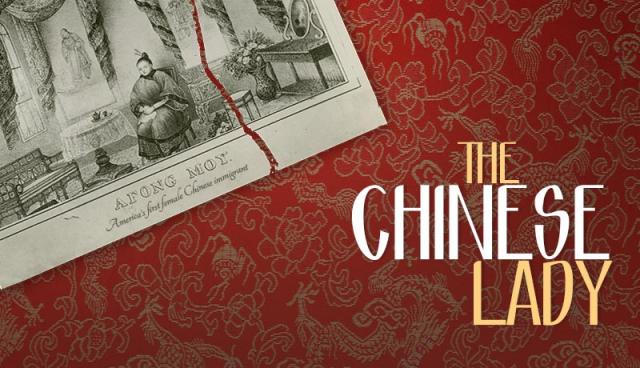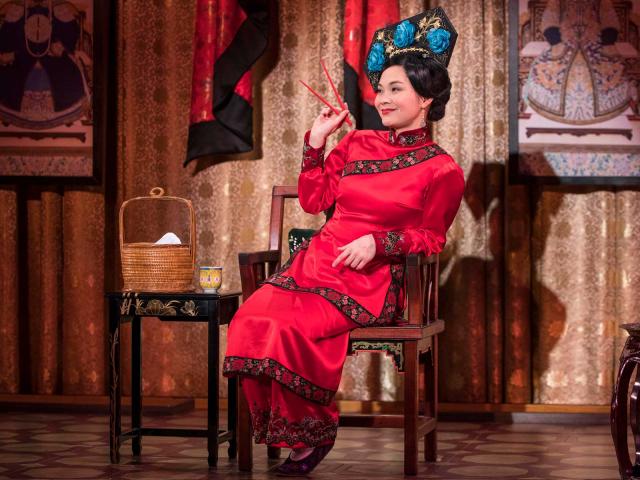

Lloyd Suh’s play, The Chinese Lady, takes us on a journey with the first real-life Chinese woman to enter the United States. In 1834, Afong Moy (Lisa Helmi Johanson) was brought over from Beijing to America and put on display by U.S. distributors attempting to sell Chinese goods. The Milwaukee Repertory Theater takes this fascinating pearl of a play and examines each of its facets. Under May Adrales’ able direction, Suh’s characters raise questions about identity, cultural stereotypes, and ageism.
The play takes place inside a large shipping crate, which looks almost like a lacquered box, painted black with decorative accents in red and gold. The unique set (by Collette Pollard) opens to reveal a beautiful young girl, sitting primly on a carved chair. She is surrounded by elements that one might find in a Chinese home, although she instructs the audience (in English) that the set-up is entirely fictitious. We are told that her knowledge of English is also fictitious, and to prove it, she points to Atung (Jon Norman Schneider), who serves as her handler and translator.
We follow Afong’s life story through her early years until she is middle-aged. The original agreement between the distributors and her Cantonese family was that she was to stay for only two years. For a reason unknown to history (and us), she remains on display for more than 20 years.
Afong re-enacts her opening spiel every time a bright red curtain surrounding the box is opened by Atung. She understands that her mission is to “show you things that are exotic and foreign and unusual.” Visitors pay a quarter to see Afong speak, eat (with chopsticks) and circle around her small, cage-like setting on tiny, four-inch bound feet. She is dressed brilliantly in a colorful silk costume (by Melissa Ng).
Although Atung sometimes translates her words into pidgin English for the curious visitors, in truth Afong is a fascinating communicator. She considers herself to be an ambassador from a foreign land, which is far beyond the influence of someone who sits on a set all day. She observes the many changes of the 20th century from afar, as only an observer.
Some of the play’s humor stems from Afong’s limited understanding of the United States (such as her desire to go on a 40-city US tour that includes Pittsburgh).
By far the best scene in the play is when Afong travels to Washington and has an audience with “emperor” Andrew Jackson. As she attempts to explain to President Jackson how her presence can be used increase understanding and respect between the two countries, it’s clear (from Atung’s portrayal of the US president) that he considers Afong to be no more than a sideshow curiosity. Meanwhile, Atung spares Afong’s feelings by telling her what she wants to hear. Afong is somewhat suspicious, especially when Jackson asks to touch her tiny feet. Afong considers this a great insult, and she turns her head away as if to distance herself from the great man who commits so intimate an act.
Atung has a solo scene near the end of the 90-minute play, in which he reveals his passions and protectiveness towards Afong. It’s clear that there is some sexual tension going on between them, but America has no suitable context in which they can express their feelings for each other. Finally, when Atung abruptly storms off the stage after revealing that he is going to remain with the show after Afong is replaced, he is immediately missed, despite his self-described “irrelevance.”
Although the play creates a somewhat realistic portrayal of Afong’s early years, it fails to bring the story to a satisfying conclusion. Historians have yet to find out what happened to Afong, whether she stayed in America or journeyed home to China. All we know is that she eventually was replaced by a younger version of herself, just as most modern performers are today. Unfortunately, the play’s ending seems like tacked-on nonsense, as if to bring Afong’s spirit into the present.
